GOAT of GOATs: Who are the Greatests Of All Time?
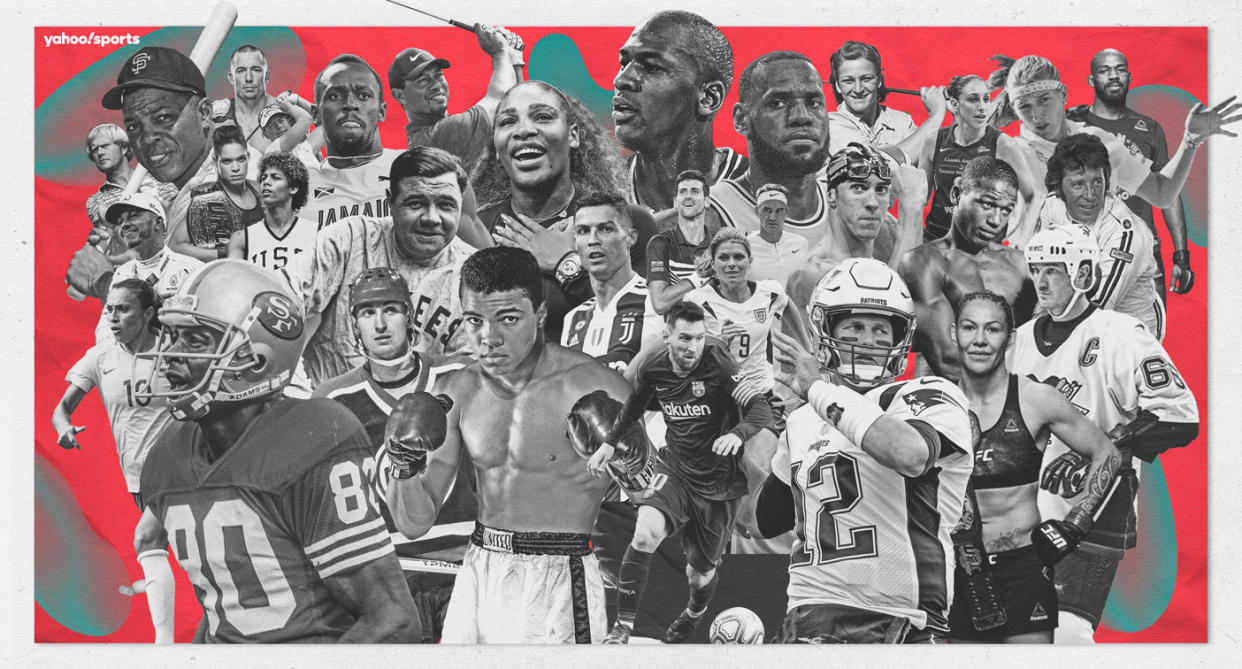
Who is the GOAT of GOATs? The greatest of the greatests? An answer to the question: Who is the greatest athlete of all time?
Before we can determine the GOAT of GOATs, we must clarify who those GOATs are. So we enlisted a team of sport-specific experts to narrow down the field. And now we’re asking you to vote.
When you do, keep this in mind: It’s impossible to compare players of different eras. Babe Ruth vs. Willie Mays is an unanswerable argument. What we can attempt to determine is this: Who dominated their respective eras more?
Newsletter: The Yodel
Trusted news and daily delights, right in your inbox
See for yourself — The Yodel is the go-to source for daily news, entertainment and feel-good stories.
So have at it. Your votes will determine a field of 16, from which we will determine who is The GOAT of GOATS.

The case for Tom Brady
As the MVPs, Pro Bowls, records and Super Bowl rings pile up, it becomes difficult to argue against anyone but Tom Brady as the greatest NFL player of all time. Perhaps there's some distinction to be made between "greatest player" and "greatest résumé," considering so much of NFL success is based on being in the right situation (and Brady has been in an incredible one), but why belabor the point when Brady's résumé blows anyone else's away? He has more Super Bowl rings than any other player in NFL history. He won his first championship at age 24 and his latest at 41, and it's unlikely that will ever be matched. He is one of five players with at least three MVP awards, and tied for the all-time record with 14 Pro Bowls. And he's still adding to his legacy.
The case for Jerry Rice
On any list of the NFL's unbreakable records, Rice's name will appear many times. His 208 career touchdowns are 33 more than anyone else in NFL history — someone would have to score 12 touchdowns for 18 straight seasons to pass Rice. His 1,549 receptions and 22,895 yards are incredible. Only one other player has more than 16,000 career receiving yards — Larry Fitzgerald, who is 5,812 yards behind Rice. Rice's 22 touchdown receptions in 1987 are second all-time in a single season to Randy Moss' 23, and Rice did it in 12 games. Are clutch performances your criteria? Rice is the only player with a 200-yard receiving game in Super Bowl history. Rice is the only player to catch three touchdowns in a Super Bowl ... and he did it twice. He holds Super Bowl career records in catches, yards and touchdowns. His 589 Super Bowl receiving yards is far beyond Lynn Swann, in second place with 364. Whether we're judging on longevity, single-season dominance, big games in the playoffs or practically any other category, Rice laps the field.
— Frank Schwab
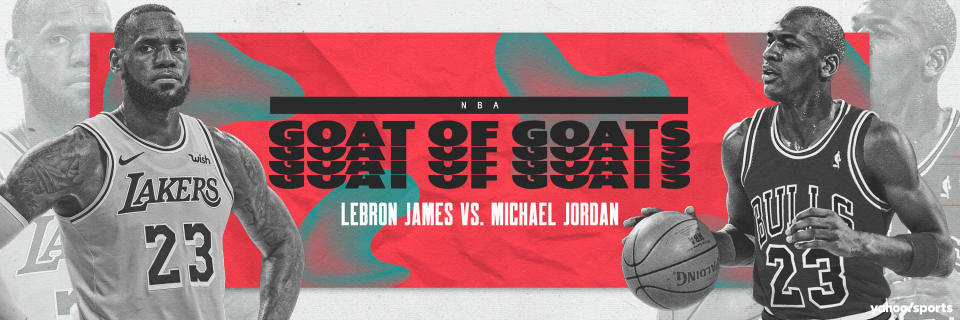
The case for LeBron James
No other player in NBA history has been so good for so long as LeBron James. Not even Michael Jordan. When all is said and done, LeBron could rank as the league’s all-time leading scorer and top three in career assists for both the regular season and playoffs. Nobody has accounted for more points, and it is hard to believe anyone ever will. A blend of brawn and brains, he led his teams to eight straight Finals — more than anyone since Bill Russell’s Boston Celtics dominated a 10-team league — including an upset of the 73-win Golden State Warriors that may well be the single greatest achievement in NBA history. And he is not done yet.
The case for Michael Jordan
Michael Jordan was so good his claim to the NBA’s GOAT throne is still gaining momentum almost a quarter-century after his retirement from the Chicago Bulls, as “The Last Dance” documentary has reminded us how thoroughly he eviscerated the league. Jordan went six-for-six when a title was on the line, winning Finals MVP each time. He added five regular-season MVPs, three more scoring titles than anyone else in history and a Defensive Player of the Year award. But no amount of honors or statistics can properly calculate how much fear Jordan’s blend of skill, athleticism and confidence struck into opponents’ hearts when the game mattered most.
— Ben Rohrbach

The case for Cheryl Miller
One day in high school, Reggie Miller came home excited that he had scored 39 points. Alas, that wasn’t even the high for his family that day. His sister had also played. She scored 105. Cheryl Miller was the most dominant women’s basketball player of the pre-WNBA era, California’s all-time leading scorer in high school and a four-time All-American and two-time national champion at USC. The competition has drastically improved since Miller’s heyday, but she’d have been a star in any era.
The case for Diana Taurasi
Anointing Diana Taurasi as women's basketball's all-time best player requires considering two different questions: Is she the most accomplished player of the WNBA era? And does she compare favorably against past icons who dominated less competitive eras? In both cases, the answer is yes. Taurasi is the WNBA’s all-time leading scorer, most dynamic playmaker and undisputed “Queen of Clutch.” Ask Taurasi’s peers who they would want to have the ball with the game hanging in the balance, and her name comes up most frequently. The bigger the moment, the better she plays.
— Jeff Eisenberg

The case for Willie Mays
Willie Mays was ahead of his time. As baseball has gotten stronger, faster, smarter and more in love with “five-tool players” — what we’re really yearning for is Willie Mays. Mays was the first five-tool player and still the best five-tool player. He has the accolades you’d expect for a GOAT conversation. He hit 660 homers (fifth all time), finished his career with a .302 batting average, was an All-Star an incredible 19 straight years, won 12 Gold Gloves and, of course, is a Hall of Famer. Simply put, he could do it all on the baseball field. For all the A-Rods, Trouts and Griffeys that came in the following decades, no one has been able to put together a career that matches Mays’.
— Mike Oz
The case for Babe Ruth
Why is Babe Ruth baseball’s GOAT? Let’s put it this way: For every other athlete in this series, you could say that he or she was “the Babe Ruth of their sport” and you’d have a good case without writing another word. But since we have the space: More than eight decades after his last plate appearance, Ruth is still the career leader in two of the game’s most important stats: WAR (182.5 games) and OPS (1.1636). He’s third in home runs (714), second in RBI (2,214) and 10th in career batting average (.342). And if you want dominance, in 1927, Ruth hit 60 home runs — more than the total posted by 12 of the 15 other teams. Also, here’s what the all-time home run list looked at the end of 1935, Ruth’s final year: 1. Babe Ruth - 714; 2. Lou Gehrig - 378; 3. Jimmie Foxx - 302; 4. Rogers Hornsby - 300; 5. Al Simmons - 256. Oh, and he won 94 games and owned a career 2.28 ERA as a pitcher.
— Kevin Kaduk

The case for Wayne Gretzky
The “Great One” racked up 2,857 points in his 20-year career and would own the NHL’s all-time scoring record even if you took away his career goals (894) and counted only his assists (1,963). A nine-time MVP, Gretzky was so brilliant he was able to cast a shadow on three men who would otherwise have great GOAT cases: Gordie Howe, Bobby Orr and Mario Lemieux.
— Kevin Kaduk
The case for Mario Lemieux
OK, so Wayne Gretzky has the overall numbers on his side, but consider this: Mario Lemieux played 915 career games, which doesn’t even put him in the top 250 in NHL history, yet he ranks 11th all-time in goals scored (690), 12th in assists (1,033), eighth in points (1,723) and seventh in goals created (649.71). In the 12 seasons he and Gretzky overlapped, he bested No. 99 with more goals and points per game. Back issues and Hodgkin lymphoma limited his play, but when he was on the ice, he was as good as anyone ever was.
— John Parker

The case for Jack Nicklaus
Jack Nicklaus didn’t have a poster of Tiger Woods on his wall growing up. That’s not just an obvious historical certainty, it’s a sign of what Nicklaus had to achieve. He owns golf’s ultimate record — 18 majors — and finished second an astounding 19 times. In the decade of the 1970s, Nicklaus finished outside the top 10 in only five of 40 majors. Five. If you needed a player to sink a putt to save your life, you’d pick 2000-era Tiger. But if you needed a player to win a tournament, you’d go with Jack Nicklaus, every time.
The case for Tiger Woods
Choosing between Jack and Tiger is almost impossible; in any ranking, they’re 1 and 1a. But if we’re talking dominance — and we are — then Tiger’s stretch from 1999-2002 is without comparison. He won five of six majors, including four in a row, and seven of 11. His 82 PGA Tour wins put him in a tie for first, ahead of Jack’s 73. The distance between the two is minuscule, and that’s with Tiger’s near decade of dealing with injuries.
— Jay Busbee

The case for Annika Sorenstam
Sorenstam spent the 2000s virtually matching Tiger Woods win-for-win. She retired in 2008, having won 72 LPGA Tour events and another 18 international events. She claims 10 majors, won Player of the Year eight times, and recorded the lowest seasonal average on Tour six times. She’s also the only female golfer ever to shoot 59 in an official event, and her 2003 — two majors, 11 total wins — remains one of the finest seasons ever compiled by any golfer.
The case for Babe Didrikson Zaharias
We ought to be calling this entire feature “the Babe of Babes,” because it’s tough to come up with anyone who could match the athletic accomplishments of Babe Didrikson Zaharias across multiple sports: an All-American in basketball, a three-time Olympic medalist and, to date, the only athlete to ever medal in running, throwing and jumping events. And then she took up golf, where she won 41 LPGA Tour events and 10 majors. She also pulled off the Grand Slam — all three available majors — in 1950.
— Jay Busbee

The case for Messi
Lionel Messi has never won a World Cup. But over 16 years and counting, he has undoubtedly risen above a former GOAT (Pelé) who won three. He's conquered the Champions League four times. He’s dominated Spain’s La Liga – and dominated Cristiano Ronaldo in the process. His goal-plus-assist numbers (1.15 per match) are preposterous, unlike anything the modern game has ever seen. And he’s done all of this, with grace and ingenuity, in the most defensive-minded era in soccer history. His brilliance is unequaled.
The case for Ronaldo
Cristiano Ronaldo has never won a World Cup. But he has won a Euro and five Champions League crowns – more than any other player in the 21st century. He’s scored more knockout-stage goals in the world’s most competitive soccer competition than any other player, ever. He’s terrorized four different leagues and left countless elite defenders helpless, first as a flashy winger, then as a lethal striker, each iteration of CR7 prolific in unprecedented ways. He and Messi are the two greatest players to ever walk the earth. Ronaldo’s game and résumé are more diverse.
— Henry Bushnell

The case for Mia Hamm
Michelle Akers, the USWNT’s first superstar, rose further above her peers than anybody else in women's soccer history. But Mia Hamm rose above more often, for a longer period of time, in more ways than one. She scored 158 international goals (second all time, male or female) and assisted on 144 (most all time) en route to two World Cups and two Olympic golds. Sixteen years after her retirement, Hamm is still a cultural icon, and still – arguably – women's soccer's GOAT.
The case for Marta
Six FIFA World Player of the Year awards. Thirteen club trophies on three different continents. More World Cup goals and more club goals than any other woman, ever. What else could you ask for? A World Cup or Olympic crown, of course, and Marta doesn’t have one. Now, that’s absolutely not her fault. Brazil’s decades of neglect for women’s soccer sapped support, on the field and off it. If Marta were American, she very well might have five major international titles and undisputed GOAT status. One could argue that indeed makes her the undisputed GOAT; that we shouldn’t penalize her for failures around her. One could also, however, argue that’s analogous to saying Tom Brady would be American football’s GOAT even with zero rings instead of six.
— Henry Bushnell
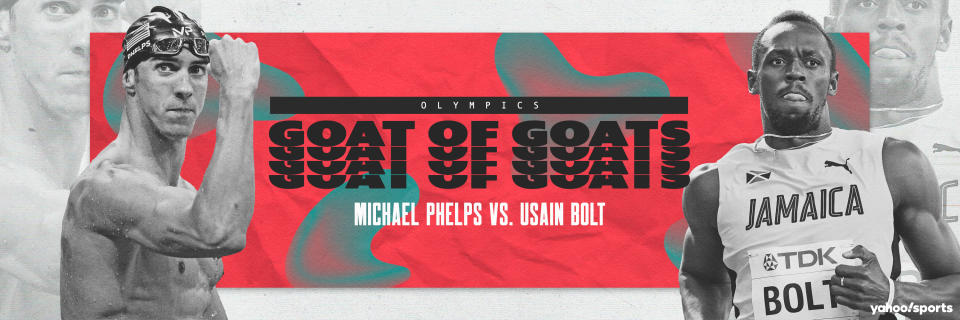
The case for Usain Bolt
Over the course of three separate Olympics — 2008 Beijing, 2012 London and 2016 Rio — Usain Bolt was literally unbeatable. He won eight gold medals across the 100m, 200m and 4x100m relay events; his relay team was stripped of another 4x100m gold from 2008 when a team member tested positive for a banned substance. But he never got beat on the track, running so far ahead of everyone else that he was even able to, in the middle of a 100-meter sprint, turn around and smile at his competition.
— Jay Busbee
The case for Michael Phelps
Michael Phelps has … deep breath … won 28 Olympic medals, 10 more than anyone else; collected 23 golds, 14 more than anyone else; has the single most dominant Olympics in history, winning eight golds in 2008; has set 39 world records; set a world record at 15, won gold medals in his 30s. Oh, and he’s won 20 more Olympic medals than Usain Bolt.
— Pat Forde
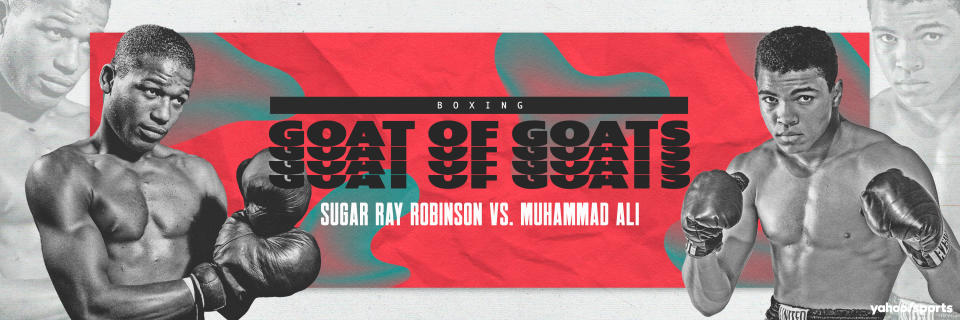
The case for Muhammad Ali
No matter which version of Muhammad Ali you pick — the fast, agile, almost-impossible-to-hit-boxer of his youth or the wily, gritty tough guy who returned after more than a three-year exile from his sport — he has an argument as the greatest of all time in his sport. Ali won an Olympic gold medal, held the heavyweight title on three occasions, went 11-3 against opponents who wound up in the International Boxing Hall of Fame and became the biggest star the sport has ever known. Ali always said that he patterned himself after Sugar Ray Robinson and that he believed Robinson to be the greatest boxer who ever lived. If it’s good enough for him, it’s good enough for me. But Ali has a very strong case in his own regard as boxing’s GOAT.
The case for Sugar Ray Robinson
Sugar Ray Robinson is the greatest boxer of all time. Muhammad Ali said so. So did Joe Louis. After going 85-0 as an amateur, Robinson started his professional career with 40 consecutive victories. He lost a 10-round decision to Jake LaMotta, then went 88-0-2 with one no contest in his next 91 bouts, putting his career mark at 128-1-2 by the time he was 30 years old. He had 13 victories over boxers who eventually were elected to the International Boxing Hall of Fame.
— Kevin Iole

The case for Jon Jones
Jon Jones is unarguably the most dominant MMA fighter the sport has seen. He’s 26-1 and his only loss came in a disqualification that was a mistake by the referee. He is 14-0 in UFC title fights and has beaten six former UFC champions and a reigning Bellator champion.
The case for Georges St-Pierre
Georges St-Pierre is really the fighter who put the mixed into mixed martial arts. He came from a karate background, but became a true mixed martial artist and a formidable wrestler. He fought all of the greatest opponents of his era and won convincingly nearly every time out. And after a long time away, he came back to the sport he once dominated, moved up a class and choked out Michael Bisping to win a second title.
— Kevin Iole

The case for Cristiane ‘Cyborg’ Justino
“Cyborg” turned pro as an MMA fighter at 19 years old and was submitted by a knee bar in just 1:46. But it would then be more than 13 years before she lost again as she became the most dominant women’s fighter of her time. She won 20 fights straight, 18 by knockout, including 10 in the first round. She won world titles in Strikeforce, Invicta, the UFC and Bellator and set a standard that few women have ever reached.
The case for Amanda Nunes
Amanda Nunes is the greatest women’s mixed martial arts fighter of all time because of her extraordinary punching power, submission skills and wins over the legends of the sport. She needed less than one round to finish Ronda Rousey, Cris “Cyborg” Justino, Miesha Tate and Holly Holm, and has a pair of victories over reigning UFC women’s flyweight champion Valentina Shevchenko.
— Kevin Iole
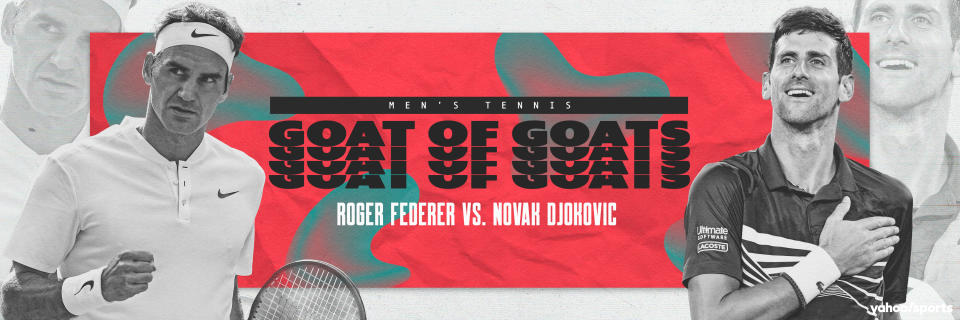
The case for Roger Federer
Roger Federer’s six-year run from 2004-09 remains unapproached in its dominance in the history of men’s tennis: World No. 1 for 237 straight weeks (second best is Jimmy Connors at 160); winner of 14 of 24 Grand Slams; finalist in six others; completion of the career Grand Slam. In one stretch, he reached the finals in 10 straight Grand Slam events and in 17 of 18. That stretch alone cements him in the conversation of the greatest ever. That he accumulated a record 20 Grand Slam titles playing in the same era as Rafael Nadal and Novak Djokovic, Nos. 2 and 3 on the Grand Slam list, only augments Federer’s résumé.
The case for Novak Djokovic
Roger Federer holds in the edge in Grand Slam victories, plus weeks at No. 1, but Novak Djokovic is coming. Six more months and he’ll catch Federer for weeks at No. 1, and when tennis resumes he’ll be favored at every Slam but the French. Of the three in the conversation for greatest men’s tennis player of all time (Djokovic, Federer and Rafael Nadal), only one has held all four Grand Slam titles at once: Djokovic. Oh, and he has a career 25-22 record, including a 4-1 edge in Slams, versus Federer.
— Jay Hart

The case for Steffi Graf
Conventional wisdom says Serena Williams is the GOAT of women’s tennis. Objective analysis proves it’s Steffi Graf. Williams completed the “Serena Slam” (holding all four major titles at once, spread over two years); Graf completed the actual Grand Slam (winning all four in a single year, plus Olympic gold). Serena’s stood at No. 1 for 319 weeks total; Graf stood there for 377. Serena’s won 72 tournaments; Graf won 107. And since this is about who dominated their respective competition more: Serena’s won 23 Grand Slams to Graf’s 22, but needed 58 tries to get to 22; Graf did it in 42 tries. Serena’s best Grand Slam stretch is 14 of 36; Graf’s is 20 of 36. And while Serena won three majors in a year twice, Graf did it five times.
— Jay Hart
The case for Serena Williams
Serena Williams has been a force on the circuit for so long that even after going through a life-threatening childbirth, losing in a Grand Slam finals is considered a colossal disappointment. But a quarter-century after her debut, the 23-time Grand Slam winner is still a favorite in any tournament against up-and-comers half her age. She is the greatest player of all time for her success, her late dominance and the impact she’s had off the court from overcoming racist attitudes to putting on display the antiquated policies of tennis simply by wearing a catsuit.
— Cassandra Negley

The case for Mario Andretti
The greatest race car drivers are the ones that are the most adaptable. And that’s why Mario Andretti is the greatest of all time. Andretti was great in every car that he raced. He won three USAC championships, the 1967 Daytona 500, the 1969 Indianapolis 500, the 1978 Formula 1 World Championship and the 1984 CART title. His team also finished second in class in the 1995 24 Hours of Le Mans when Andretti was 55.
The case for Lewis Hamilton
Unlike Mario Andretti, Hamilton hasn't become a cross-discipline superstar. His greatness in different types of cars and series is simply unknown. But we do know that Hamilton is the greatest driver in Formula 1. And Formula 1 is the top racing series in the world. He's won over a third of his Formula 1 starts — 84 victories in 251 races — and has taken five of the last six championships. And the six-time world champion is the favorite to win the 2020 title. A seventh title would tie Hamilton with Michael Schumacher for the most of all time and seven more wins will tie Schumacher for the most Grand Prix wins of all time.
— Nick Bromberg
Solve the daily Crossword

